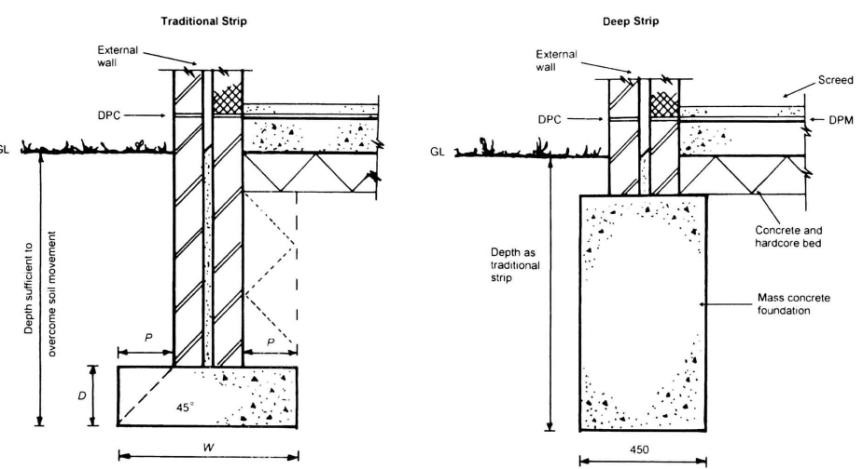Stepped foundation
Foundations provide support for structures, transferring their load to layers of soil or rock that have sufficient bearing capacity and suitable settlement characteristics.
Strip foundations (or strip footings) are a type of shallow foundation used to provide a continuous, level (or sometimes stepped) strip of support to a linear structure such as a wall or closely-spaced rows of columns built centrally above them.
Where the natural surface of the ground is sloped, the most economical solution may be a stepped foundation. In this case, the foundation takes the form of a series of concrete horizontal steps following the slope of the ground.
This helps to minimise the amount of excavation and below-ground wall construction that would otherwise be required. Stepped foundations can also be used to transition from deep foundations to shallow foundations, and at corners and intersections.
Regularly stepping foundations also avoids abrupt and excessive changes in level that could cause a weakness resulting in movement. Similarly, abrupt and excessive changes in foundation depths should be avoided at corners and intersections by the introduction of stepping.
Each step in the foundation should be no higher than the thickness of the foundation. The foundation at the higher level should also overlap the lower foundation, typically by at least twice the height of the step, or by the thickness of the foundation, or by at least 300 mm (whichever is greatest).
Drainage must be carefully designed to eliminate the danger of instability due to accumulating water pressure.
[edit] Find out more
[edit] Related articles on Designing Buildings Wiki
Featured articles and news
British Architectural Sculpture 1851-1951
A rich heritage of decorative and figurative sculpture. Book review.
A programme to tackle the lack of diversity.
Independent Building Control review panel
Five members of the newly established, Grenfell Tower Inquiry recommended, panel appointed.
Welsh Recharging Electrical Skills Charter progresses
ECA progressing on the ‘asks’ of the Recharging Electrical Skills Charter at the Senedd in Wales.
A brief history from 1890s to 2020s.
CIOB and CORBON combine forces
To elevate professional standards in Nigeria’s construction industry.
Amendment to the GB Energy Bill welcomed by ECA
Move prevents nationally-owned energy company from investing in solar panels produced by modern slavery.
Gregor Harvie argues that AI is state-sanctioned theft of IP.
Heat pumps, vehicle chargers and heating appliances must be sold with smart functionality.
Experimental AI housing target help for councils
Experimental AI could help councils meet housing targets by digitising records.
New-style degrees set for reformed ARB accreditation
Following the ARB Tomorrow's Architects competency outcomes for Architects.
BSRIA Occupant Wellbeing survey BOW
Occupant satisfaction and wellbeing tool inc. physical environment, indoor facilities, functionality and accessibility.
Preserving, waterproofing and decorating buildings.






















Comments
What are the rebar design standards for stepped footing rebar?
are 90 degree hooks at step down acceptable?